Over Spring Break during my senior year of high school, one of my friends from the previous year’s graduating class flew home from UCLA to visit his family and spend some time at home. He texted me before the plane took off down the runway, asking if I’d be home that evening and would have a few minutes for him to stop by after dinner with his mom.
Later that night, he drove over and handed me a package, explaining that he loved that particular store located near the college campus, popped in frequently, and thought it’d be the perfect gift for me. He also revealed that he had been slightly stressed about packing the present in his luggage—he didn’t want it to break!
I opened up the bag and peered inside…
To find a baker’s dozen of gigantic cookies from Diddy Riese!
He laughed at my surprised look, followed by the huge grin that started to spread across my face. As I slowly sifted through the different flavors, he shared that he had swung by the bakery as his last stop before driving to the airport to ensure the cookies were as fresh and soft as possible. What an amazing friend!
I tried to eat just one cookie each day, but… With the stress of college decision deadlines quickly approaching, the thirteen cookies disappeared in just over a week! Out of all of the varieties in that package—chocolate chip, M&M, oatmeal raisin, double chocolate chip, and snickerdoodle—the latter was actually my favorite (yes, even as a chocoholic!) because of its rich buttery flavor paired with the cozy cinnamon. I was so glad that my friend had given me four of those!
And that particular cookie served as the inspiration for today’s recipe, this Skinny Single-Serving Snickerdoodle Mug Cake! Because I don’t live near that bakery—and really don’t want to know how many calories are in each of their snickerdoodle cookies!—I created a healthier alternative with the same irresistible flavors. Even better, this sweet treat is ready in just a few minutes!
Unlike many traditional mug cake recipes that depend on a full egg and a few tablespoons of butter (umm, that’s at least 270 calories alone right there—yikes!), this lighter version contains only ¼ teaspoon of butter and no eggs. That’s right! We’re shaving off tons of calories, but this mug cake is still just as moist and tender.
How’d I do it?
With my favorite ingredient in healthier baking: Greek yogurt! Greek yogurt provides that same moisture as extra butter for a fraction of the calories. It also gives your mug cake a little protein boost too, and that extra protein in the Greek yogurt helps imitate the protein from the egg white that gives a traditional mug cake its structure.
Instead of the tablespoon or two of granulated sugar in other mug cakes, this one is sweetened with powdered stevia and vanilla crème stevia, one of my new favorite finds. Stevia is a plant-based, no-calorie sweetener that’s clean eating friendly. It’s very concentrated, so a little goes a long way! I love SweetLeaf’s products, both for the powdered stevia and vanilla crème stevia, and you can find these at many health-oriented stores, as well as online. (You’ll use them in all of these recipes of mine, too!)
I have a secret ingredient that gives this mug cake that classic buttery snickerdoodle flavor… Butter extract! It’s similar to vanilla extract, and almost all grocery stores should carry it. You can find it near the other extracts on the baking aisle. (Walmart stores also sell a big bottle on their wedding aisle!) It’s shelf-stable and keeps for ages, and it’s also fairly inexpensive!
Finally, you can’t have snickerdoodles without that cozy spiced coating… So you’ll sprinkle a combination of granulated Swerve and cinnamon on top just before popping it in the microwave.
I also have a secret trick to ensuring that the mug cake turns out with a perfectly tender texture, like cupcakes you’d bake in a regular oven… Microwave it at 30% power! This lower power better simulates a regular oven and prevents the cupcake from turning rubbery. I use it for all of my single-serving microwave recipes—it works like a charm!
Ready to make your own? After you do, leave me a comment—or share a picture with me on Instagram! I’d love to see your mug cake!
| Skinny Single-Serving Snickerdoodle Mug Cake | | Print |
- for the mug cake
- 3 tbsp (23g) white whole wheat flour or gluten-free* flour (measured like this)
- ⅜ tsp powdered stevia
- ⅛ tsp baking powder
- ⅛ tsp cinnamon
- 1/16 tsp salt
- ¼ tsp unsalted butter or coconut oil, melted
- 1 tbsp (15g) plain nonfat Greek yogurt
- 1 ½ tbsp (23mL) nonfat milk
- ⅛ tsp vanilla extract
- ⅛ tsp butter extract
- 18 drops vanilla crème stevia, or to taste
- for the topping
- ¼ tsp granulated Swerve
- tiny pinch of cinnamon
- Lightly coat a 1-cup ramekin with nonstick cooking spray.
- In a small bowl, whisk together the flour, powdered stevia, baking powder, and salt. In a separate bowl, stir together the butter, Greek yogurt, and milk.* Stir in the vanilla extract, butter extract, and vanilla crème stevia. Gradually mix in the flour mixture, about 1 tablespoon at a time, until just incorporated.
- Spread the batter into the prepared ramekin. Prepare the topping by stirring together the Swerve and cinnamon, and sprinkle on top of the mug cake batter. Microwave on 30% POWER for 2 minutes 35 seconds (2:35). Let the mug cake cool for at least 2 minutes to allow the center to finish cooking through before enjoying.
Whole wheat pastry flour or all-purpose flour may be substituted for the white whole wheat flour.
Any milk may be substituted in place of the nonfat milk.
Extra vanilla extract may be substituted for the butter extract; however, the mug cake will lack that iconic buttery snickerdoodle flavor.
You’ll use two types of stevia in the mug cake batter because too much of either type results in a very bitter aftertaste to the mug cake. Other sweeteners may be substituted in place of both the powdered stevia and vanilla crème stevia, but you may need to adjust the amount of flour or milk depending on the type of sweetener that you use. You’ll need the equivalent of 2 ½ tablespoons of granulated sugar.
If the yogurt and milk are cold, they will immediately re-solidify the melted butter. If this happens, microwave on HIGH for 6-8 seconds or until the butter re-melts; then proceed with the rest of the instructions.
For the topping, Truvia, coconut sugar, or granulated sugar may be substituted for the granulated Swerve.
It’s VERY important to microwave the mug cake on 30% power. This is set differently depending on the brand of microwave that you own. If microwaved on HIGH (full power) for a shorter time, the cake will be gummy, and the top may be overdone while the insides stay raw.
Microwave times may vary, depending on the wattage of your microwave oven. I used a 1000-watt microwave.
To bake the mug cake in a regular oven, bake at 350°F until the top feels firm to the touch and a toothpick inserted into the center comes out clean. I haven’t cooked the mug cake this way myself and can’t guarantee how long it will take, but check for doneness after about 12-14 minutes to start.
{gluten-free, clean eating, low fat, low calorie, high protein}
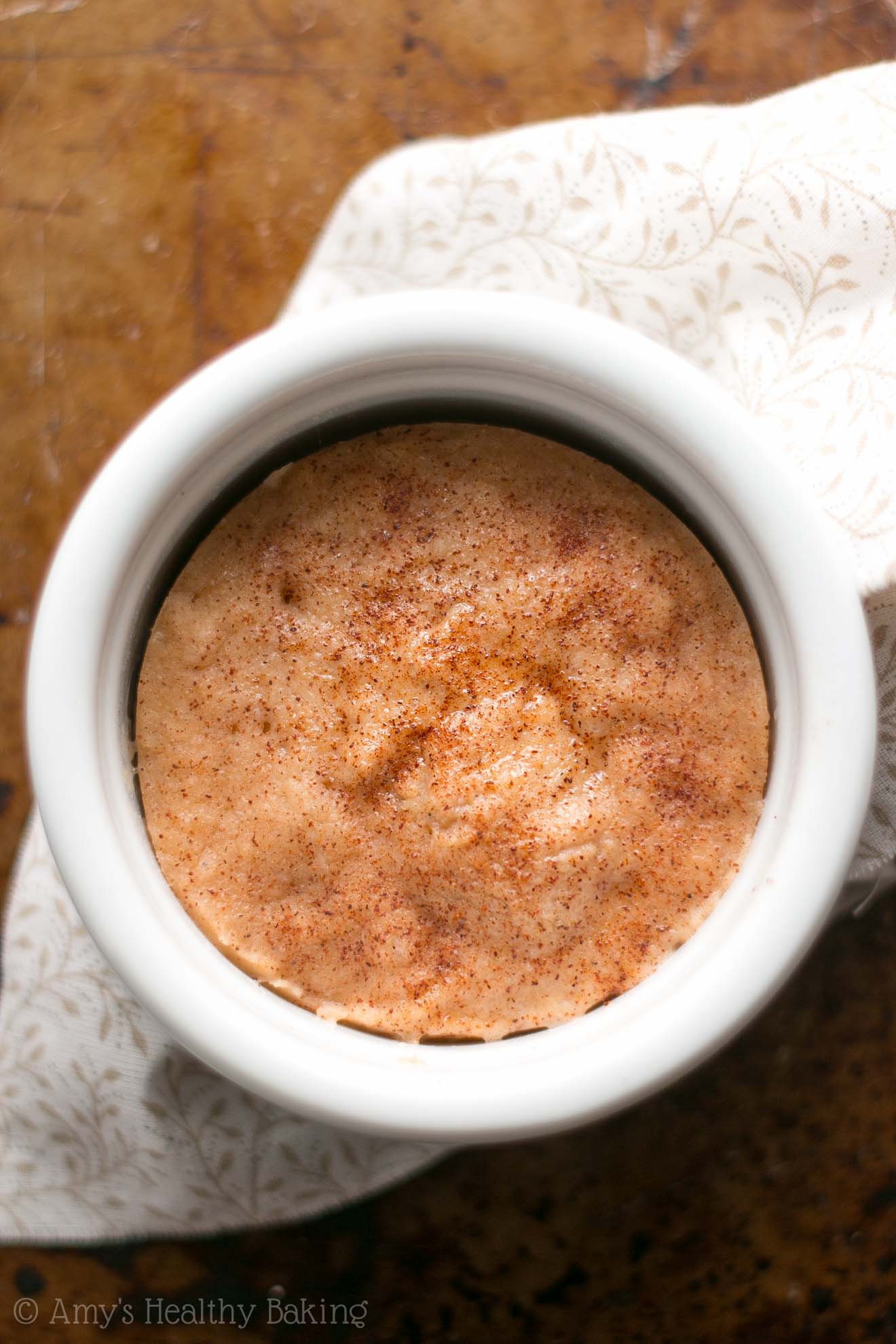


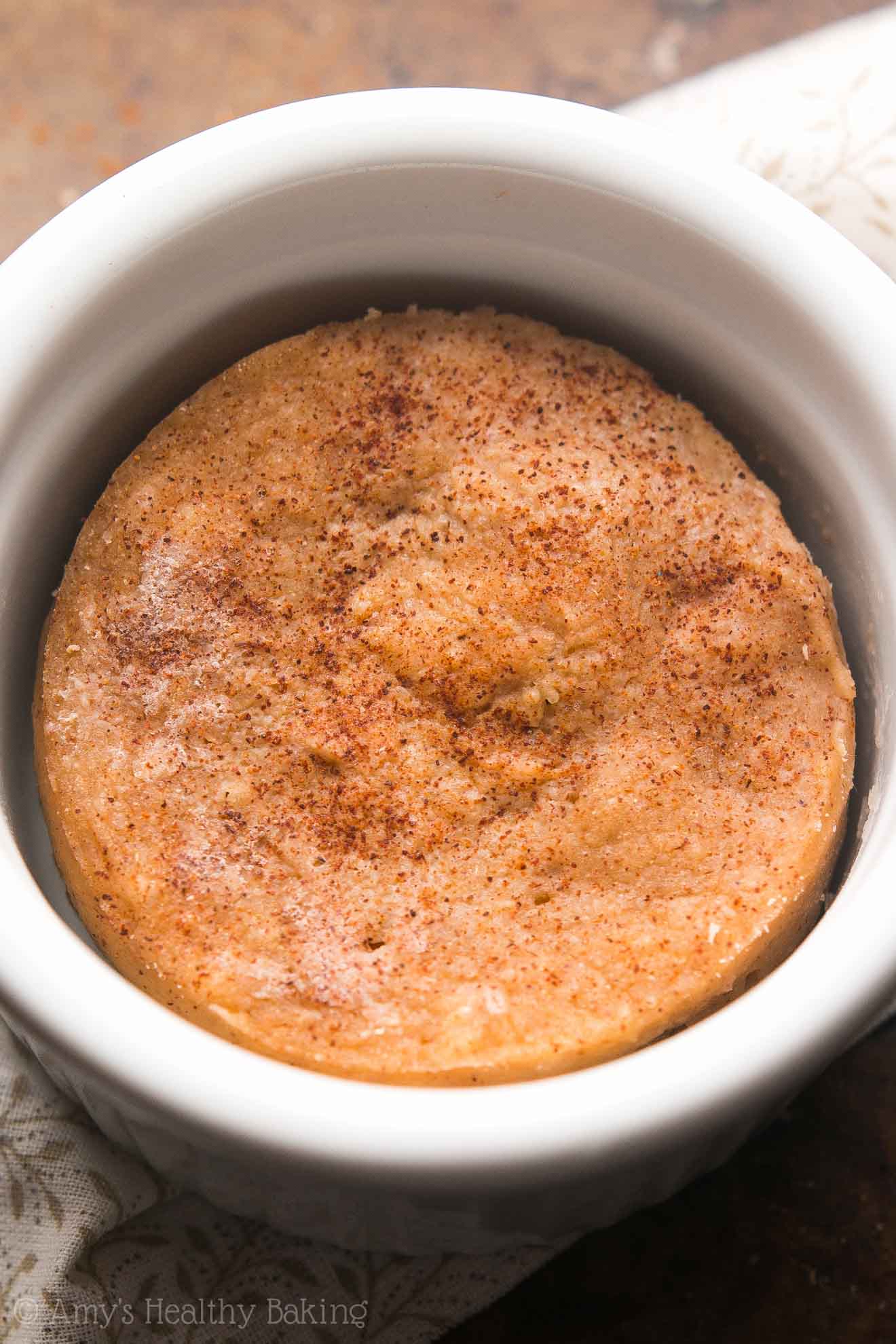
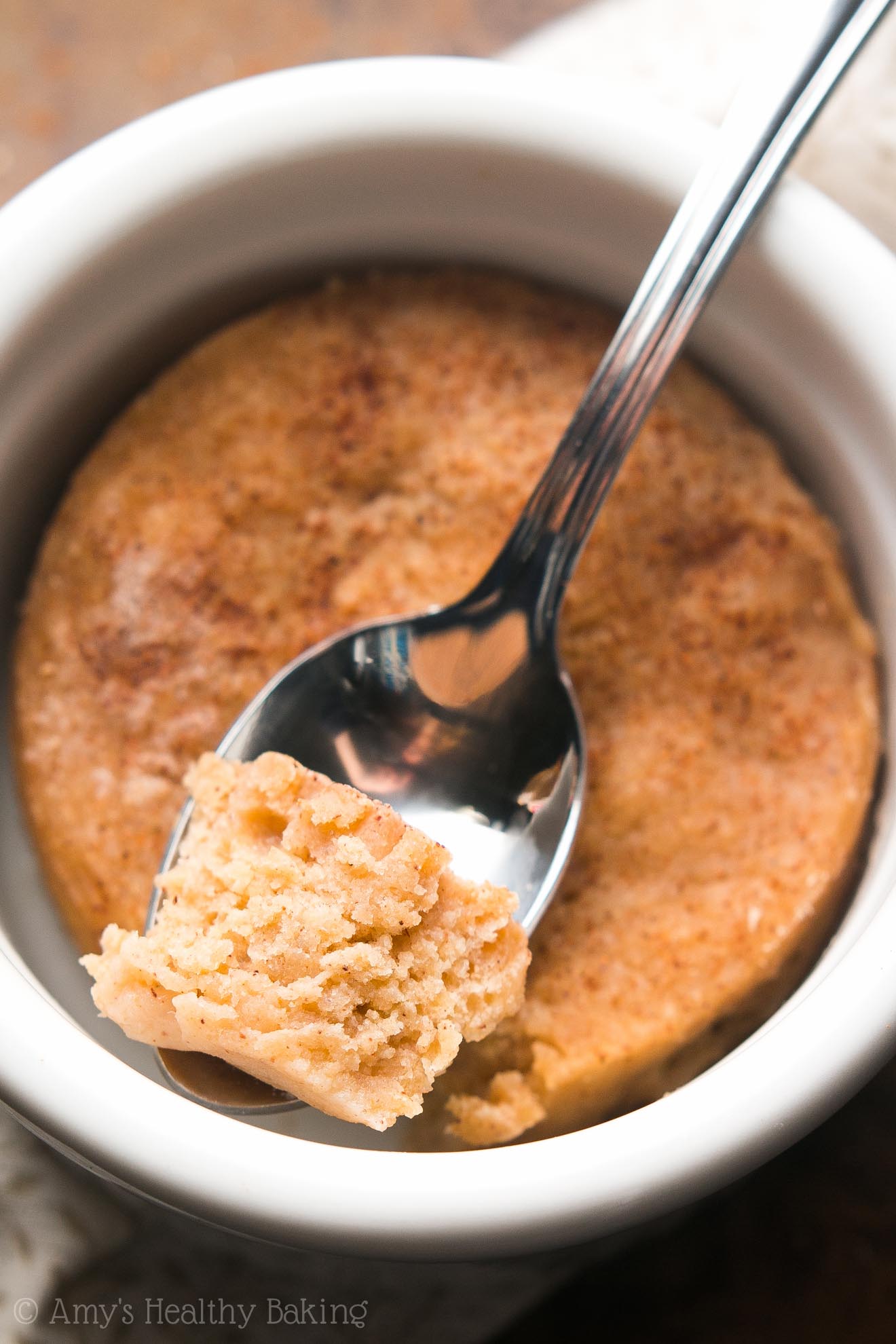
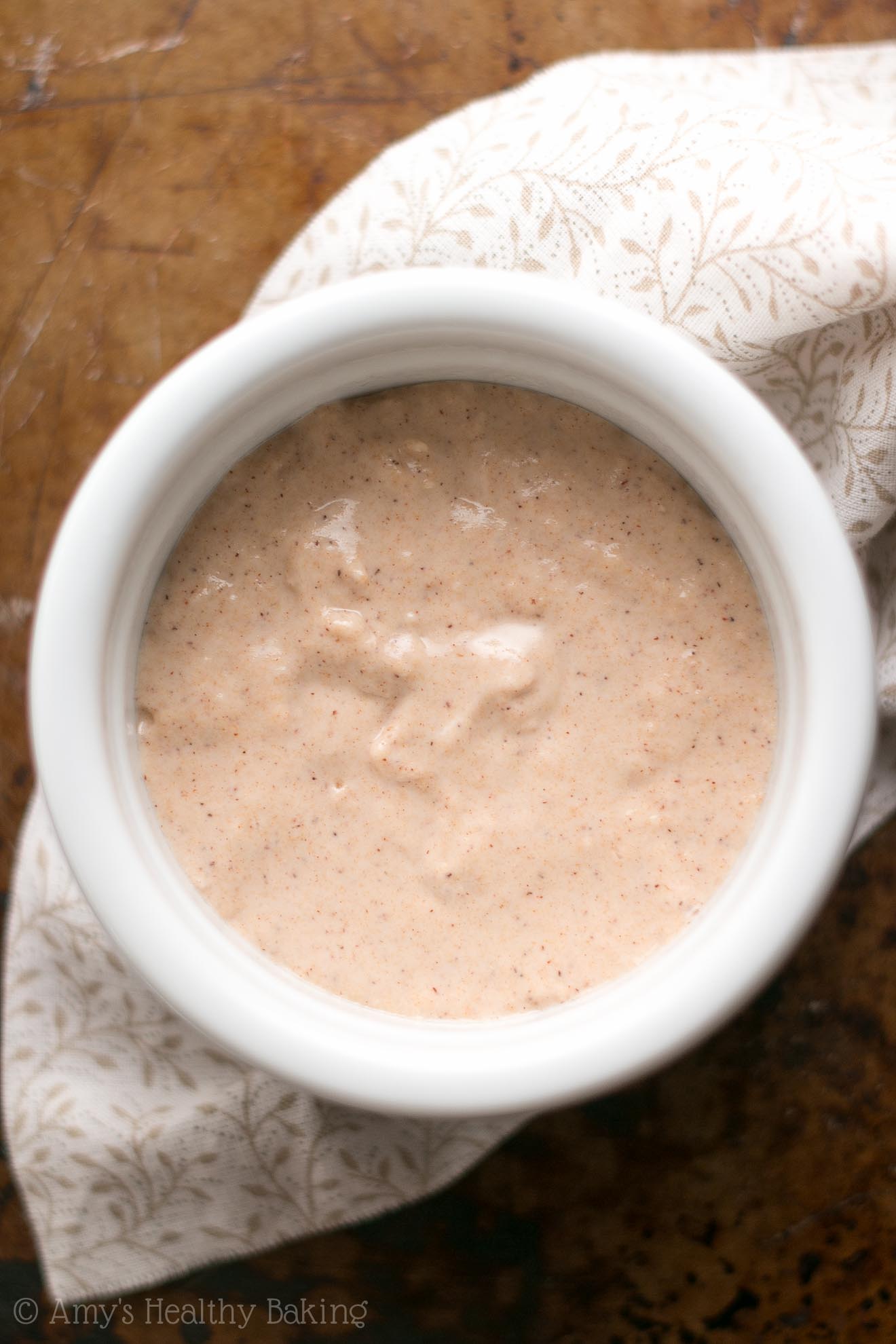
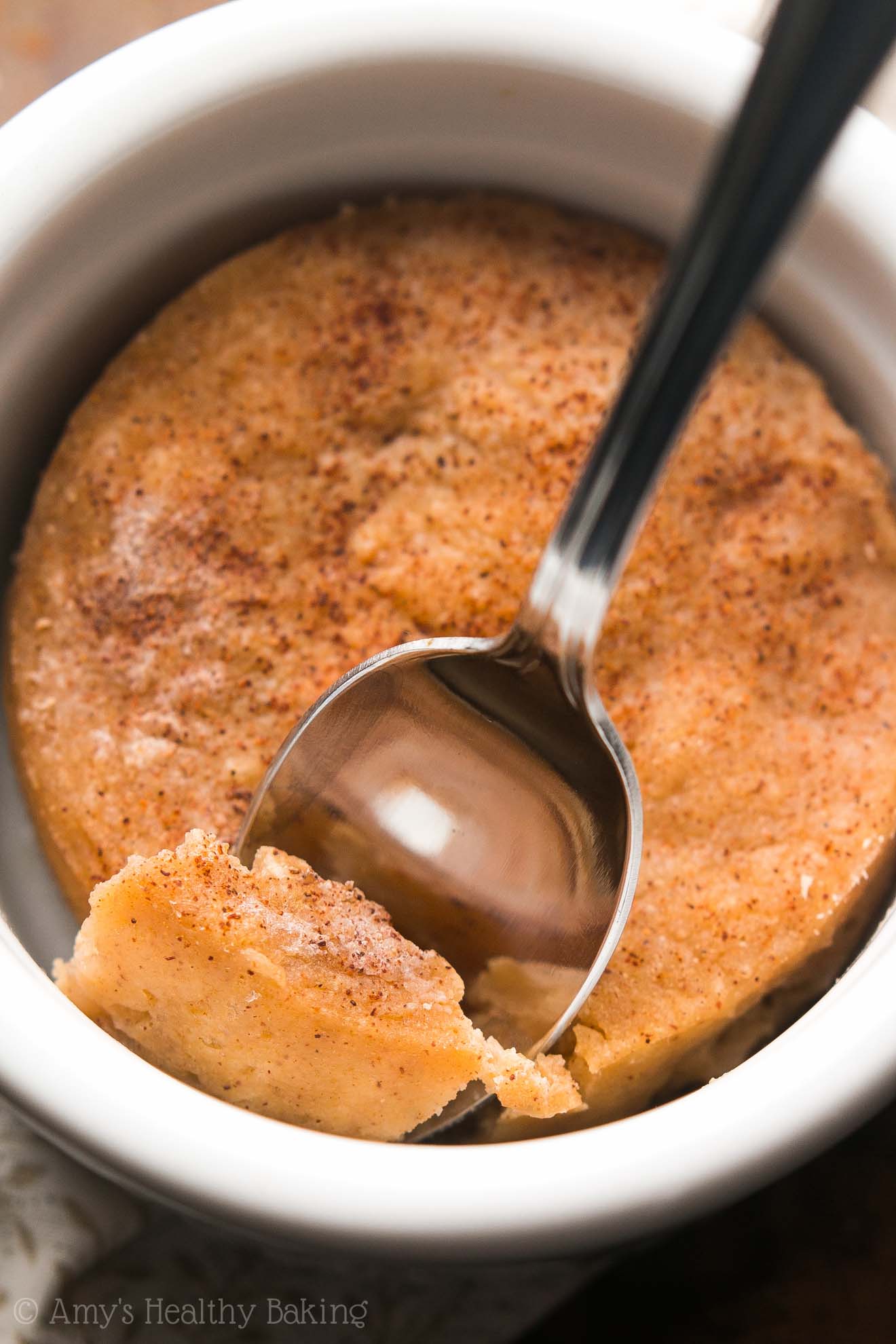
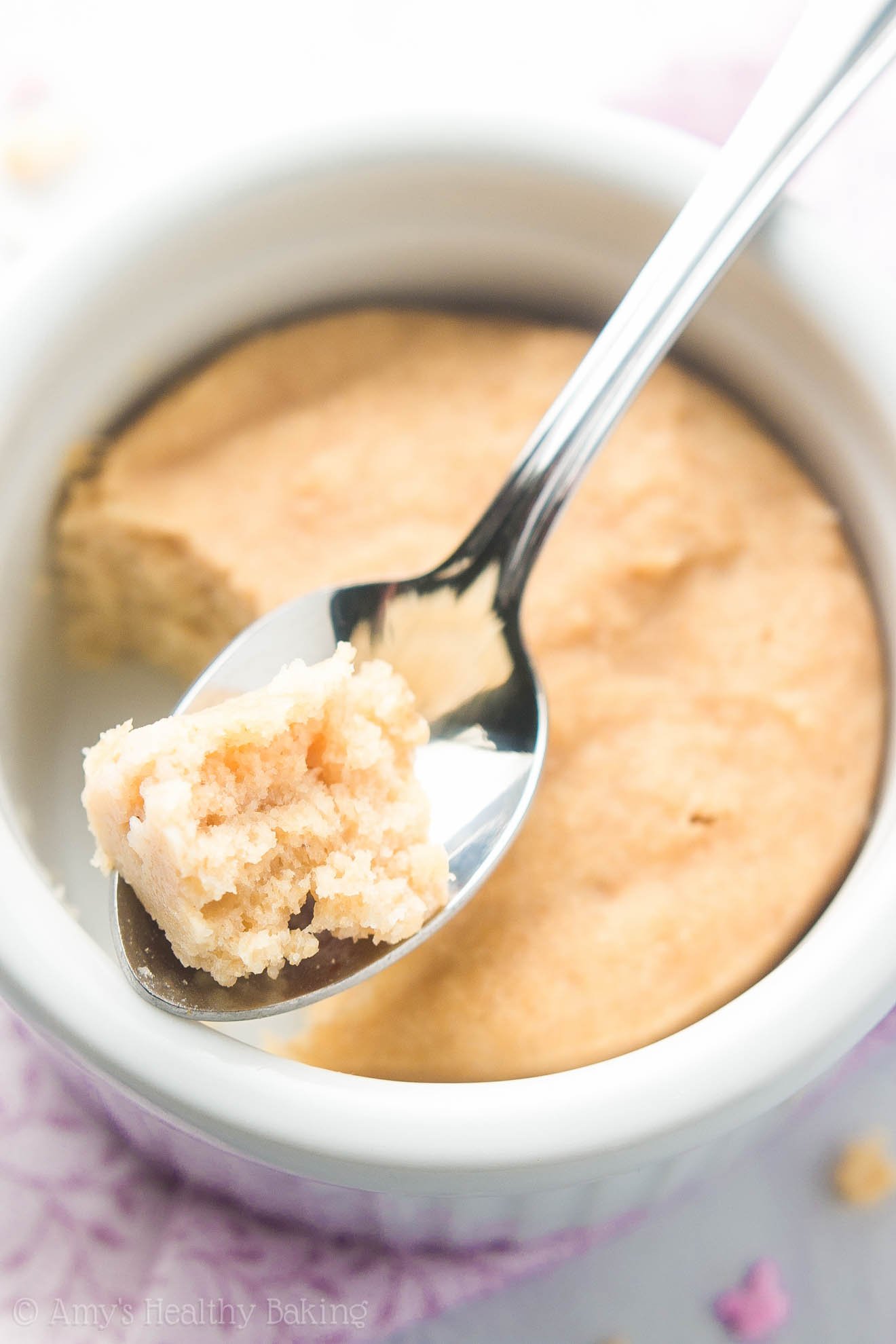
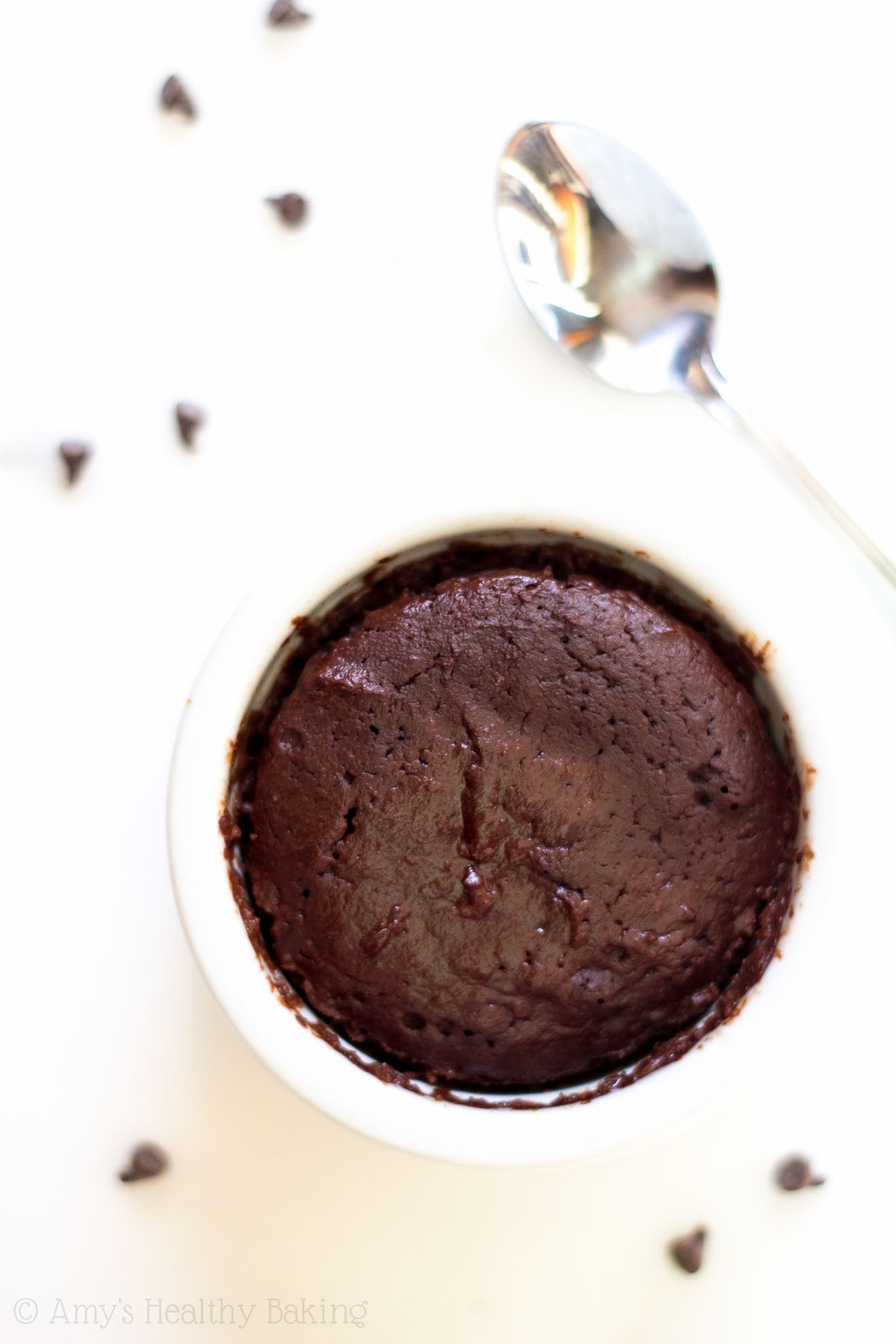
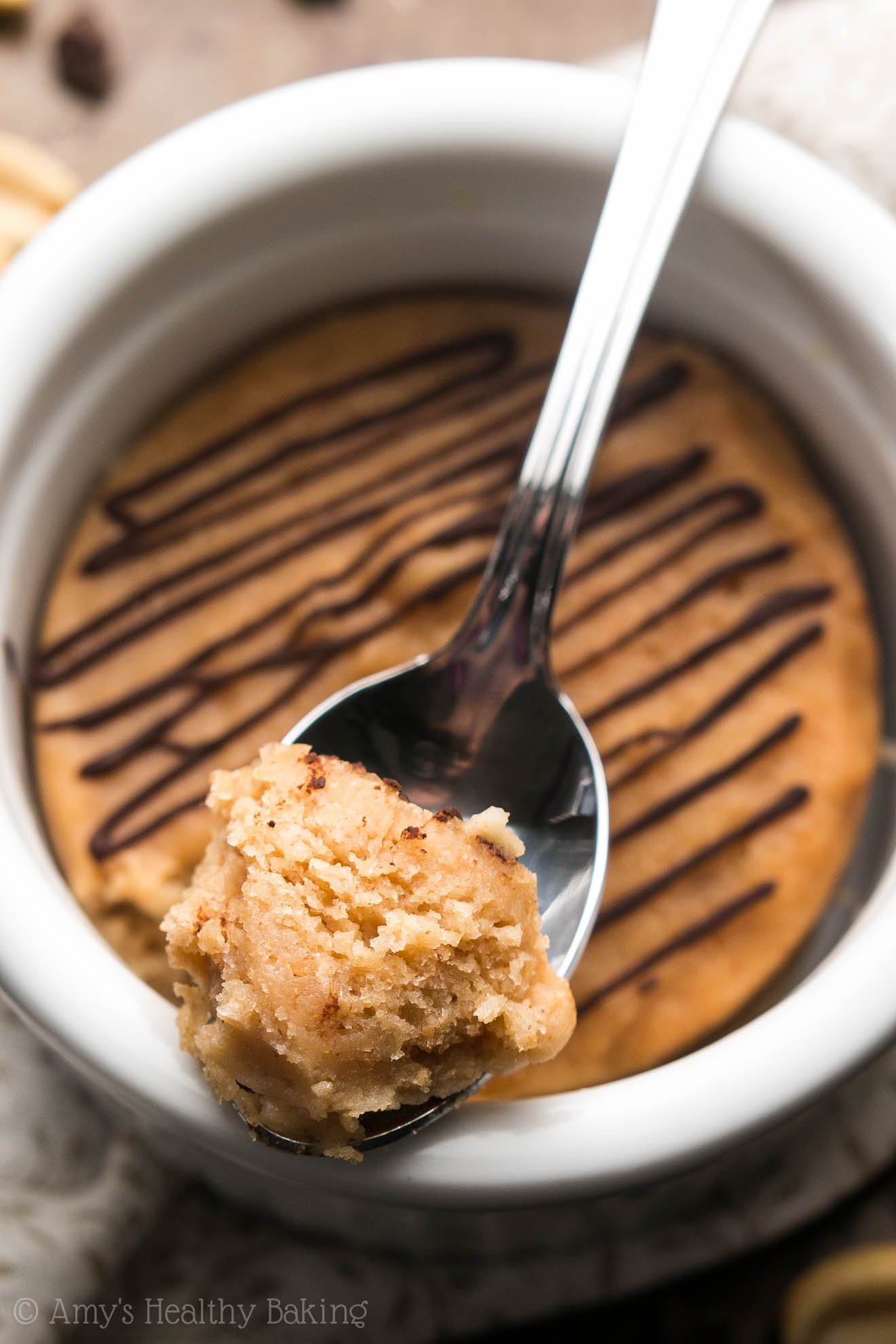

This looks permit for me as I love sweets but I’m trying to loss some extra pounds. Thank you for serving these up 😉
I hope you enjoy the mug cake Teddy! 🙂
Aw thank you so much Amy 🙂 i believe all mug cakes should be like this: cozy, tender, healthy… Real comfort food that is good for both our body and mind!! All of your mug cakes are like that, this one expecially!!:)
I’m so glad you loved this mug cake Sam! That means a lot to me! 🙂
Amy;
hi,i just copied your skinny single serving snickerdoodle mug cake recipe, and I am going to make this mug cake after I buy some groceries at the end of this month, and I will let you know what I think of your mug cake.
I have five little ramekens and I was wondering how I can make the recipe to fit the five ramekens to share with my family.
kim
I really appreciate your interest in this recipe of mine too, Kim! If you’d like to make 5 mug cakes to share with your family, you can certainly multiply the ingredients by 5 and divide the batter between the ramekins. If you’re going to make them in the microwave, I recommend cooking one ramekin at a time to ensure they turn out properly. Otherwise, you can pop your ramekins in the oven instead! See the bottom of the Notes section underneath the Instructions for more info about that. 🙂 I can’t wait to hear how your mug cakes turn out!
Amy;
Hi,I can’t find the stevia creme but I found a bottle of sweetleaf stevia vanilla at the bulk bark and the vitality stores in the town where I live with my family.can I use this product instead of the stevia creme in your recipes?
Kim
Yes! You can definitely substitute that for the vanilla creme stevia in my recipes. 🙂 I can’t wait to hear what you make first with it Kim!
Hi! Can we replace both stevias with erythritol? And should we then increase or decrease the milk/yoghurt please? 🙂
I really appreciate your interest in my recipe, Tahlia! If you’d like to replace both stevias with erythritol, then you’ll need 2 ½ – 3 tablespoons for the mug cake batter. You’ll most likely need to reduce the milk to compensate, but because I haven’t personally tried that substitution, I’m not sure by how much. I’d recommend starting with ½ tablespoon of milk and increasing as necessary. (The batter should be on the thick side!)
I’d love to hear what you think of this mug cake if you try making it!
I tried this one today, and it didn’t rise at all. It tasted nice, but it had a dense, gluey texture. I used Besti granulated allulose blend as a sweetener and didn’t adjust anything else. I’m a totally inexperienced baker, so I have no idea if I should have added more milk or flour to compensate for the different sweetener. I did measure the flour by weight, so I feel confident that wasn’t what went wrong. Any hints?
It means a lot that you tried my recipe, Jennifer! That sounds disappointing and not like how this mug cake should turn out, so I’d love to help figure out what happened. In order to do so, I have some questions for you! 🙂
Did you make any other substitutions or modifications to the recipe, including those listed in the Notes section, other than using Besti’s sweetener?
It looks like Besti offers a few different allulose blends. Was it one with monk fruit? If so, was it the brown, crystallized, or powdered blend?
How much of that allulose blend did you use to replace both stevia products in the batter?
Did you weigh anything else besides the flour?
Can you describe the batter’s consistency before microwaving it? Was it thick, thin, stiff (like cookie dough), etc?
Do you know the wattage of your microwave, by any chance?
Did you use 30% power? (People sometimes forget to reduce their microwave’s power before cooking the mug cake, which is why I ask! 😉 )
How long did you microwave it?
When you removed the mug cake from the microwave, did the center still look a bit raw? Or was it fully cooked all the way through?
I know I just asked a LOT of questions, but I’ll have a much better idea of the culprit and how to fix it once I know your answers to all of them! 🙂
Whew! Yes, a lot of questions. LOL. Thanks for getting back to me. I have so many of your recipes bookmarked it’s not even funny. (I made your chewy chocolate chip cookies with much greater success.)
I used all purpose flour instead of white whole wheat, because it was what I had. I also used the extra vanilla instead of the butter extract.
I used 2 TBSP of the crystalized Besti monk fruit/allulose blend in place of both Stevias, and the flour was the only ingredient I weighed.
The batter had the consistency of most mug cake batters I’ve made, so nothing suspicious about it. (Not that I have all that much experience even with that, but it looked as I expected a cake batter to look.)
I believe the microwave is 1000 watts, although when I went looking for confirmation, I couldn’t seem to find it anywhere. I definitely cooked it on 30% power for 2:35.
It’s hard to say whether the center looked cooked or not–really the whole thing didn’t look quite cooked because it was so gluey and flat, although it had pulled away from the sides of the mug. I tried cooking it some more on high power just to see if that changed the consistency at all in case it just wasn’t quite done, but 20 seconds on high made no perceivable change, so I think there was just something wrong.
Thank you SO much for thoroughly answering all of these questions, Jennifer! That makes my job much easier. 😉 I’m truly honored that you’ve bookmarked so many of my recipes too. That’s a huge compliment!!
After reading through your answers (again, thank you for answering all of them!), it sounds like the batter was fine, especially if you think it was a decent consistency, and something about the microwave was the culprit. For mug cakes, I’ve found that it’s better to under-bake them and stop when the center still looks slightly glossy or wet. I like to use the sides as an indicator for mug cakes (and for brownies too!). When they start pulling away from the pan, it means they’ve been baked long enough, even if the center still looks underdone.
Mug cakes continue to cook, even after you pull them from the microwave, for another few minutes while you let them cool on the counter. Over-baking can lead to that gummy or tough texture, so I think baking your mug cake for less time or at a lower power level (or both!) would improve the texture.
If you’re up for trying it again, I’d recommend using 20% power for 2 minutes to start. If the entire top still looks wet and raw, pop it back in at 20% power for 20-second intervals. When only the very center looks a little glossy, it should be done.
Does all of that make sense? 🙂
That makes sense. I may try it again, or I may not because I have so many other recipes I want to try. I made your buttermilk cornbread today and really loved it! (I’d never made my own buttermilk before–great technique. Smells and tastes just like buttermilk–without having to have most of a quart of buttermilk left in the fridge not getting used.)
Oh my goodness — another one of my recipes, so soon?? You just put the biggest smile on my face, Jennifer! That means so much!! 🙂 I’m really glad you enjoyed it, and thank you for taking the time to let me know too!